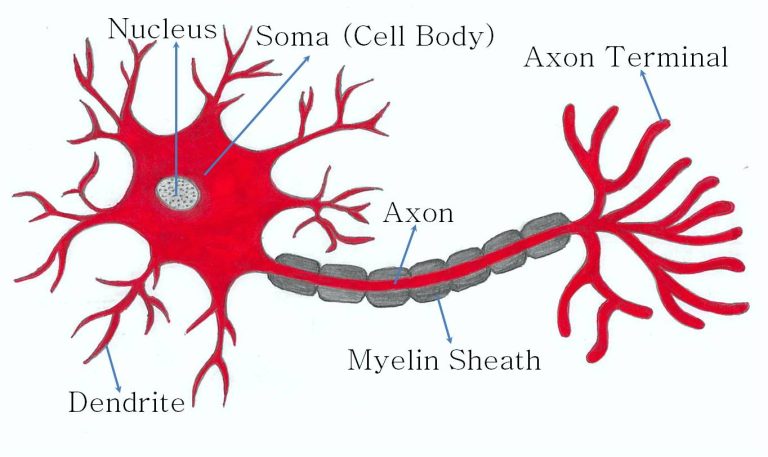A neuron is a nerve cell that processes and transmits information through electrical and chemical signals in the nervous system. Neurons consist of three main parts: dendrites, a cell body, and an axon.
Dendrites are branch-like structures that receive messages from other neurons and allow the transmission of messages to the cell body. The cell body contains the nucleus and other organelles that maintain the neuron’s function. The axon is a long, thin extension that carries electrical impulses from the cell body to the axon terminals, which pass the impulses to another neuron through a gap called the synapse.
Synaptic connections allow communication between neurons, facilitating the relay of information throughout the body. In chemical synapses, the action potential affects other neurons through the release of neurotransmitters, which are chemical messengers that excite or inhibit the postsynaptic neurons. In electrical synapses, the action potential is directly transmitted through gap junctions, which are channels that connect the cytoplasm of two adjacent neurons.
Neurons can be classified into three types based on their function: sensory neurons, motor neurons, and interneurons. Sensory neurons carry information from the external or internal environment to the central nervous system (CNS), which consists of the brain and the spinal cord. Motor neurons carry information from the CNS to the muscles or glands, causing them to contract or secrete. Interneurons connect different neurons within the CNS, forming networks that PROCESS AND INTEGRATE information.
Next, we should appreciate the role and the mechanism to which sodium ion propagate communication in a neural system.
Sodium ions (Na+) play a crucial role in neural communication by creating and propagating electrical signals called action potentials. Action potentials are rapid changes in the membrane potential of a neuron that allow it to transmit information to other neurons, muscles, or glands.
The mechanism of sodium ion propagation is as follows:
– When a neuron is at rest, it maintains a negative membrane potential (about -70 mV) by pumping out more Na+ than it takes in, using a protein called sodium-potassium pump. This creates a concentration gradient and an electrical gradient for Na+ across the membrane.
– When a neuron receives a stimulus, such as a neurotransmitter from another neuron, some of the Na+ channels on the membrane open, allowing Na+ to flow into the cell down its gradient. This causes the membrane potential to become less negative (depolarize).
– If the depolarization reaches a certain threshold (about -55 mV), more Na+ channels open, triggering a positive feedback loop that rapidly depolarizes the membrane to about +40 mV. This is the peak of the action potential.
– After the peak, the Na+ channels close and the potassium (K+) channels open, allowing K+ to flow out of the cell down its gradient. This causes the membrane potential to become more negative again (repolarize).
– The repolarization overshoots the resting potential, making the membrane more negative than usual (hyperpolarize). This is called the refractory period, during which the neuron is less likely to fire another action potential.
The **refractory period** of a neuron in neural dynamics is defined as the time during which a neuron is unable to fire a new action potential. This period is crucial for the proper functioning of neural communication.
The Refractory Period can be divided into two phases:
1. **Absolute Refractory Period (ARP)**: During this phase, the neuron is completely unresponsive to any additional stimuli, no matter how strong. This is due to the inactivation of sodium channels that were opened during the previous action potential. The neuron cannot initiate another action potential during this time¹.
2. **Relative Refractory Period (RRP)**: This phase immediately follows the ARP. In this interval, a neuron can potentially fire an action potential, but only if the incoming stimulus is significantly stronger than usual. This is because the membrane potential is closer to the potassium equilibrium potential due to the outward movement of K+ ions, which causes a brief hyperpolarization of the membrane.
These periods ensure that action potentials move in one direction along an axon and help maintain a clear signal by preventing the overlapping of action potentials.
– The sodium-potassium pump restores the original concentration gradient of Na+ and K+, bringing the membrane potential back to the resting state.
The action potential travels along the axon of the neuron by sequentially opening and closing the Na+ and K+ channels on the membrane. This ensures that the signal is UNIDIRECTIONAL AND DOES NOT DECAY OVER DISTANCE. The action potential reaches the end of the axon, where it triggers the release of neurotransmitters into the synapse, initiating the communication with the next neuron or the target cell.
Concluded.
Warning: Trying to access array offset on value of type null in /home/truevigy/public_html/wp-content/plugins/elementor/includes/base/controls-stack.php on line 1627
Warning: Trying to access array offset on value of type null in /home/truevigy/public_html/wp-content/plugins/elementor/includes/base/controls-stack.php on line 1629

